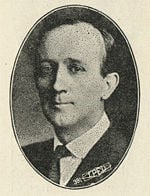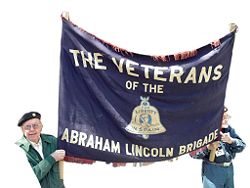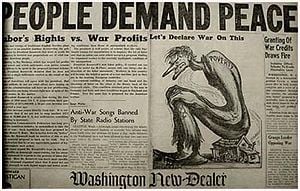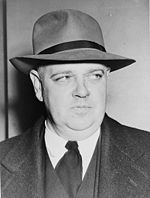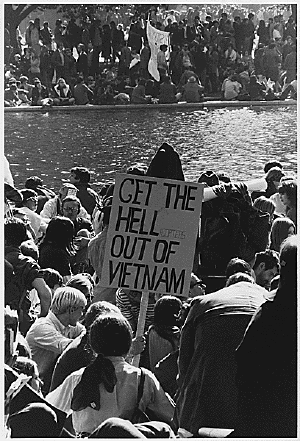| Communist Party USA | |
|---|---|
| Party Chairman | Sam Webb |
| Senate Leader | N/A |
| House Leader | N/A |
| Founded | 1919 |
| Headquarters | 235 W. 23rd Street New York, NY 10011 |
| Political ideology | Communism; Marxism-Leninism |
| International affiliation | formerly Comintern; today, none |
| Color(s) | Red |
| Website | Cpusa.org |
The Communist Party USA, formally known as the Communist Party United States of America (CPUSA) is a Marxist-Leninist political party noted for its staunchly pro-Soviet line throughout most of its history. During the first half of the twentieth century, it was the largest and most influential communist party in the country, playing a defining role in the early U.S. labor movement. The CPUSA's close collaboration with the Soviet Union led to two major Red Scares, in the 1920s and again in the 50s, on the grounds that the party was a foreign-controlled conspiracy working to overthrow the American system of democracy and capitalism.
In the late 1920s, the party was shaken by internal factionalism when Josef Stalin pursued a Soviet-centered policy and the Trotskyists moved away from the Moscow party line to emphasize revolutionary internationalism. It faced another crisis leading up to World War II as the newly formed Soviet Union shifted from a militant anti-fascist policy to a "peace" platform during the years of the Hitler-Stalin Pact, and then back to a pro-war stance when Adolf Hitler broke with Stalin and attacked the USSR.
By the end of the 1950s, the party transformed its revolutionary line into a more evolutionary one, echoing the Soviet policy of "peaceful coexistence." Many of the more militant CPUSA members and their children continued to work toward stimulating armed class warfare as the New Left. The Soviet invasion of Czechoslovakia in August 1968, led to further disillusionment and defections, but the party remained a significant force in the anti-Vietnam War protest movement.
In the late 1980s, the CPUSA became estranged from the reformist leadership of the Soviet Union, and the fall of the Soviet Union itself dealt the CPUSA another major blow. The much-diminished CPUSA today continues to call for a "peaceful transition to socialism" in the United States.
History
Formation and early history (1919-1921)
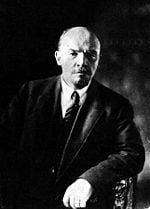
The first political party in the United States to advocate Marxism was the Socialist Labor Party, organized in 1890, some of whose members later formed the Socialist Party of America (SPA). In January, 1919, Soviet leader V.I. Lenin invited the left wing of the SPA to join the Communist International (Comintern).
After an internal power struggle, the SPA's several pro-Soviet foreign language federations and others factions turned away from the SPA and formed a new party, the Communist Party of America, at a convention in Chicago on September 1, 1919. Meanwhile, plans by Benjamin Gitlow and pro-Soviet journalist John Reed to take the SPA itself down the Soviet path failed, resulting in the pro-Soviet faction of the SPA forming the Communist Labor Party on August 30, 1919.
Lenin and the Comintern would not accept two Communist parties in the U.S., and in January 1920, the Comintern ordered the two parties to merge under the name United Communist Party and follow the party line established in Moscow. Part of the Communist Party of America, under the leadership of Charles Ruthenberg and Jay Lovestone, did as ordered. However, another faction continued to operate independently as the Communist Party of America. A more strongly worded directive from the Comintern eventually re-established discipline, and the two parties, which consisted of about 12,000 members, were merged in May 1921. Other members of the new United Communist Party were drawn from the ranks of the Industrial Workers of the World.
The first Red Scare (1919-1923)
From its inception, the United Communist Party came under scrutiny from state and federal governments as an agent of the Soviet revolution. After a series of bombings and attempted assassinations of government officials, Attorney General A. Mitchell Palmer, acting under the Sedition Act of 1918, began arresting large numbers of party members in 1919. Many of these were foreign-born recent immigrants, whom the government soon deported.
The party apparatus was thus forced underground and went through various name changes. It reemerged in 1923 with a small, legal, above-ground element, the Workers Party of America. As concern about the Soviet revolution being exported to the U.S. ebbed and the deportations of the early 1920s diminished, the party became more open. Another element of the party, however, remained permanently underground, later known as the CPUSA secret apparatus. It was through this underground operation that Soviet intelligence was able to use a select number of CPUSA members as its agents.
Factional struggles (1923-1929)
Now that the above-ground element was again legal, the party, still known as the Workers Party of America, began to devote itself to developing roots within the US working class. This represented a move away from hopes of immediate revolution, and toward a longer-term approach. It was further facilitated by decisions of the Fifth World Congress of the Comintern held in 1925, which decided that the period of revolutionary upsurge had ended. The U.S. Communists thus embarked then on the arduous work of locating and winning allies.
That work was, however, complicated by factional struggles. The Workers Party of America fairly quickly developed two main more or less fixed factional groupings within its leadership:
- A faction centered on party secretary Charles Ruthenberg, largely led by his supporter Jay Lovestone
- The so-called Foster-Cannon caucus, headed by William Z. Foster, who headed the party's Trade Union Educational League, and James P. Cannon, who led the International Labor Defense organization
The first faction drew many of its members from the party's foreign language federations, while the latter found more support among native workers and left-wing trade unionists. Foster's group had strong bonds with the "progressive" leaders of the Chicago Federation of Labor, the Progressive Party, and nascent farmer-labor parties. The Comintern, however, felt that these groups lacked adequate revolutionary potential, and the CPUSA broke off relations with both groups in 1924. In 1925, the Foster faction was ordered by the Comintern to cooperate more fully under Ruthenberg's leadership.
However, the factional infighting within the Workers Party of America did not end. Ruthenberg died in 1927, and his ally, Jay Lovestone, succeeded him as party secretary. Both Lovestone and Cannon traveled to Moscow, in 1928, to attend the Sixth Congress of the Comintern, hoping to gain an advantage for their factions.
While there, Cannon was given a copy of Trotsky's "Critique of the Draft Programme of the Comintern" and became convinced of its arguments that the Soviet Union had abandoned the principle of revolutionary internationalism in favor of Stalin's Soviet-centered policy. Lovestone, meanwhile, had impressed the Comintern leadership as a loyal supporter of Nikolai Bukharin, then the Comintern's general secretary.
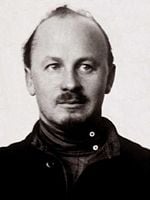
Back in America, Cannon and his associates, such as Max Shachtman and Martin Abern, began to organize support for Trotsky's theses. As a result, Cannon was expelled from the CPUSA, and he and his followers organized the Communist League of America as a section of Trotsky's International Left Opposition.
Ironically, Lovestone's support of Buhkarin would have equally devastating consequences for his party prospects when, in 1929, Bukharin was on the losing end of a struggle with Stalin. Buhkarin was soon purged from the Politburo and removed as head of the Comintern. A Comintern delegation subsequently came to the United States and demanded that Lovestone resign as party secretary in favor of his other arch-rival, Foster. Lovestone, with strong support among the CPUSA's rank and file membership, traveled to the Soviet Union and appealed directly to the Comintern. However, Stalin, whose power was now absolute, was not convinced of his friendship.
When Lovestone returned to the United States, he was purged from party leadership, ostensibly on grounds of his support for the doctrine of American Exceptionalism, the thesis that socialism could be achieved peacefully in the U.S., without violent revolution. Lovestone and his allies formed their own group, called the Communist Party (Opposition), a section of the pro-Bukharin International Communist Opposition. With the party still enamored with Stalin and the Soviet cause, only a few hundred U.S. Communists joined this new organization.
Consolidation under Stalin (1929-1935)
The upheavals within the party in 1928-29 echoed a much more general change in Soviet policy: Stalin's decision to break off any form of collaboration with non-revolutionary western socialist parties, which were now condemned as "social fascists."
This, combined with a gradual awakening of U.S. Communists to the reality of Stalinism and defections to the Trotskyists, resulted in a membership loss from about 24,000 CPUSA members in 1928 to approximately 6,000 members in 1932.
Another impact of Stalin's edict was to abruptly end the party's investment in organizing within the American Federation of Labor (AFL), launching instead the Communist-controlled Trade Union Unity League, affiliated with the Red International of Labor Unions. As general secretary, Foster followed the Soviet line on this crucial issue, even though it contradicted the relatively successful policy he had previously championed of influencing the mainstream U.S. labor groups.
By 1930 the party had adopted the title of Communist Party of the USA. It devoted much of its energy in the Great Depression to attempting to found "red" unions, organizing the unemployed, attracting African Americans by championing Negro rights, and protesting the evictions of farmers and the working poor.
In 1932, William Z. Foster, upon his retirement as party head, published a book entitled Toward Soviet America, which laid out the Communist Party's plans for revolution and the building of a new socialist society in the U.S., based on the model of Soviet Russia. Earl Browder now became general secretary of the party.
Browder moved the party even closer to Soviet interests, helping to develop its underground secret apparatus within the U.S. in cooperation with Soviet intelligence. He actively assisted in the recruitment of espionage sources and agents for the Soviet NKVD, while his younger sister Margerite was an NKVD operative in Europe until removed from those duties at Browder's request. The CPUSA's foreign policy platform came under the direct control of Stalin, who enforced his directives through the NKVD.
The Popular Front (1935-1939)
The ideological unity of the early 30s began to crack, however, with two events: the election of Franklin D. Roosevelt in 1932 and Adolf Hitler's rise to power in 1933. Roosevelt's election and the passage of the National Industrial Recovery Act in 1933 sparked a tremendous upsurge in union organizing in 1933 and 1934. While the Soviet line still favored the failed policy of creating red unions, U.S. Communists now chose to return to the earlier emphasis on infiltrating and influencing the AFL-affiliated unions they had recently been attacking as "bourgeois."
With fascism on the rise, the Seventh Congress of the Comintern accepted this change in policy in 1935, when it declared the need for a Popular Front of all groups opposed to fascism. The CPUSA thus abandoned its opposition to Roosevelt's "bourgeois socialist" New Deal and provided many of the organizers for the emerging Congress of Industrial Organizations (CIO), which took a more left-wing line than the AFL.
The party also sought unity with forces to its right. Earl Browder offered to run on a joint Socialist Party-Communist Party ticket in the 1936 presidential election but the Socialists, unwilling to associate themselves with either violent revolution or the Soviet Union, rejected his offer.
Party members also rallied to the defense of the Spanish Republic after a right-wing military uprising moved to overthrow it, resulting in the Spanish Civil War (1936 to 1939). The CPUSA, along with leftists throughout the world, raised funds for medical relief, while many CPUSA members made their way to Spain with the aid of the party to fight in the Abraham Lincoln Brigade.
However, in the late 1930s, with the authorization of President Roosevelt, the FBI began investigating both domestic Nazis and Communists. Congress passed the Smith Act, which made it illegal to advocate, abet, or teach the desirability of overthrowing the government, in 1940.
Culturally, the Popular Front period also witnessed the development of a strong communist influence in intellectual and artistic life, often through organizations supported or controlled by the CPUSA, pejoratively known "Communist fronts."
The Hitler-Stalin Pact and World War II (1939-1945)
During the CPUSA's aggressive opposition to fascism in the Popular Front period, membership in the CPUSA rose to about 75,000. However, the signing of the Molotov-Ribbentrop Pact allying the Soviet Union with Germany, in 1939, resulted in a major crisis, as thousands of Jewish and other anti-fascist members left in disgust. The CPUSA abruptly turned away from militant anti-fascism to focus its public activities on advocating "peace," opposing U.S. military preparations, and condemning those opposed to Hitler as warmongers. The CPUSA accused Winston Churchill and Roosevelt of provoking aggression against Germany and denounced the Polish government as fascist after the Germans and Soviets joined in invading Poland. Thousands more members now found that their consciences could no longer allow them to remain in the party.
Suddenly, ever faithful to the Soviet line, the CPUSA once again changed it war policy after Hitler attacked the Soviet Union on June 22, 1941. Prominent CPUSA members and supporters, such as writer Dalton Trumbo and singer Pete Seeger, attempted to withdraw anti-war material they had previously released. The leadership of the CPUSA now became one of the most vocal pro-war voices in the United States. Throughout the rest of World War II, the CPUSA opposed labor strike actions at all costs as harming the war effort, even opposing A. Philip Randolph's efforts to organize a march on Washington to dramatize black workers' demands for equal treatment on the job.
Onset of the Cold War (1945-54)
Earl Browder expected the wartime coalition between the Soviet Union and the west to bring about a prolonged period of international harmony after the war. In order to better integrate the movement into American life, the party was temporarily dissolved in 1944, and replaced by the Communist Political Association. That harmony proved elusive, however, and the Comintern and the international Communist movement swung to the left after the war ended. As a result, in 1945, Bowder was retired and replaced by former party leader William Z. Foster, who would remain the CPUSA's party chairman until 1958, while Eugene Denis, who had previously been a leading Comintern agent in China, served as general secretary. Internal opposition to yet another shift in the party line resulted in the expulsion of a number of dissidents.
More important for the party was the renewal of government suspicion of the loyalty of the CPUSA and its members. The Truman administration's loyalty oath program, introduced in 1947, drove a number of Communists and other extreme leftists out of federal employment and legitimized the notion of Communists as subversives. On July 20, 1948, Foster, Dennis and ten other party leaders were arrested and charged under the Alien Registration Act. Foster was not prosecuted, due to ill health, but Dennis and several others would eventually serve prison terms. The U.S. Supreme Court upheld the constitutionality of their convictions by a 6-2 vote in United States v. Dennis, . The government then proceeded with the prosecutions of more than 100 "second string" leaders of the party.
Panicked by these arrests and the fear that the CPUSA was compromised by informants, Dennis and other party leaders decided to go underground and to disband many affiliated groups. The move heightened the political isolation of the leadership, while making it nearly impossible for the party to function.
Meanwhile, the House Committee on Un-American Activities made even brief affiliation with the CPUSA and its front groups grounds for public exposure, inspiring local governments to adopt loyalty oaths and investigative commissions of their own. Non-government associations, notably in the motion picture industry, created watchdog groups, including the still controversial blacklist of actors, writers, and directors in Hollywood who had been Communists or had fallen in with Communist fronts in the pre-war and wartime years. The union movement purged party members as well. The CIO formally expelled a number of red unions in 1949, while labor leaders sympathetic to the CPUSA were forced out of their unions if they did not disowned their alliances with the party.
The widespread fear of Communism became more acute after the Soviets' explosion of an atomic bomb in 1949, and the discovery of Soviet espionage which gave them state secrets to do so.[1] Liberal groups, such as the Americans for Democratic Action and others, distanced themselves from Communist causes and formally defined themselves as anti-Communist. In the early 1950s, politicians like Richard M. Nixon and Joseph McCarthy made names for themselves by exposing Communists within the Truman administration.
The later 50s, 60s, and 70s
The U.S. government formally outlawed the CPUSA as an agent of Soviet revolution by passing the Communist Control Act in 1954. However, widespread persecution of communists and their associates began to abate somewhat after McCarthy overreached himself in the Army-McCarthy Hearings, producing a backlash.
Despite the relaxation of the Red Scare, the 1956 Soviet invasion of Hungary and Nikita Khrushchev's denunciation of Stalinism had a cataclysmic effect on its previously staunchly Stalinist membership.[2] Many internal critics departed from the party demoralized, but others would remain active in leftist causes and become important in the development of the New Left in the 1960s.
The post-1956 upheavals in the CPUSA and the imprisonment of Dennis and his colleagues also saw the advent of a new leadership centered on former steel worker Gus Hall, whose strict adherence to the Soviet line tolerated neither opposition to Soviet policy in Hungary nor the opinion of those who believed Khrushchev had gone too far in denouncing Stalinism.
The Supreme Court brought a halt to the Smith Act prosecutions and undermined the basis of banning membership in the CPUSA in its decision in Yates v. United States, , which required that the government prove that the defendant had actually taken concrete steps toward the forcible overthrow of the government, rather than merely advocating it in theory. The party was thus once again legal and began running presidential candidates again.
Beginning in the 1960s, the CPUSA worked to oppose the U.S. foreign policy of "Containment," which was directed against Soviet expansionism and suppressing Communist-led revolutions in the Third World. It formed new front groups toward this end and engaged in various coalitions opposed to U.S. nuclear testing, military preparedness, and especially the War in Vietnam. Communist intellectuals like Herbert Aptheker and Angela Davis helped make inroads on college campuses. The Soviet invasion of Czechoslovakia in 1968, however, brought a major setback to Communist recruiting, and both Troskyist and Maoist groups drew disillusioned members from the CPUSA ranks, as well as from the new generation of politically active "red diaper babies." Despite this, during the 1970s, the CPUSA managed to grow in membership once again to about 25,000 members, as it continued its recruitment among workers and blacks and supported the anti-Vietnam War protest movement through the Peoples Coalition for Peace and Justice.
Current era
In 1984, due to the popularity of Ronald Reagan's anti-Communist administration and decreased CPUSA membership in the post-Vietnam era, Gus Hall chose to end the CPUSA's nationwide electoral campaigns. He also took the step of criticizing Gorbachev's liberalizing reforms in the late 1980s, resulting in a cutoff of Soviet funds which forced the party's daily newspaper to go weekly.
During the 1990s, the party was shaken by the fall of the Soviet Union. It began recruiting heavily in impoverished minority neighborhoods in the U.S. Today, the CPUSA still runs candidates for local office. In recent years, the party has strongly opposed the Republican Party in the U.S., which it terms "ultra-right" and, at times, "fascist."
With the demise of the Soviet Union, the CPUSA has become more free to pursue its own ideological course and has begun reassessing the role, for example, of China. In a 2002 article in People's Weekly World, CPUSA correspondents Marilyn Bechtel and Debbie Bell said of their trip to the People's Republic of China: "[W]e came away with a new respect for the thoughtfulness, thoroughness, energy, and optimism with the Communist Party of China."[3]
An overview of the CPUSA's current ideology can be found in the report, "Reflections on Socialism," by Sam Webb, the party's current national chair. The article explains the CPUSA's support for a "democratic, anti-racist, anti-sexist, immediate left-wing" change for the United States, arguing that the fall of the Soviet Bloc was due to the fact that democracy was not sufficiently developed in these countries.
The archives of the Communist Party USA were donated, in March 2007, to the Tamiment Library at New York University. The massive donation, in 12,000 cartons, included history from the founding of the party, 20,000 books and pamphlets, and 1 million photographs from the archives of the Daily Worker. The Tamiment Library also holds a copy of the microfilmed archive of Communist Party documents from Soviet Archives held by the Library of Congress.[4]
Issues
Soviet funding
From 1959 until 1989, the CPUSA is known to have received a substantial subsidy from the Soviet Union. Documents from the Soviet archives show that all national Communist parties that conformed to the Soviet line were funded in the same fashion. Starting with $75,000 in 1959 this was increased gradually to $3,000,000 in 1987. This substantial amount reflected the Party's subservience to the Moscow line, in contrast to the Italian and later Spanish and British Communist parties, whose Eurocommunism deviated from the orthodox line in the late 1970s.
The cutoff of funds in 1989, when the CPUSA took a line opposed to Gorbachev's liberalizing reforms, resulted in a financial crisis, forcing the CPUSA to cut back publication of the party daily newspaper, the People's Daily World, to weekly publication as the People's Weekly World.
Espionage
Even more controversial than funding, however, is the alleged involvement of CPUSA members in espionage for the Soviet Union.
Long-time FBI Director J. Edgar Hoover and other U.S. experts believed that the CPUSA constituted an active conspiracy loyal to a foreign power, whose members routinely assisted Soviet intelligence in the clandestine infiltration of the American government. This once discredited view is supported by several memoirs of ex-Soviet KGB officers and information obtained from Soviet archives.[5]
In the 1950s, former CPUSA member Whittaker Chambers revealed that he had been recruited into the CPUSA underground united and acted as a Soviet spy. He identified Sandor Goldberger—also known as "Josef Peters"—as the head the CPUSA’s underground secret apparatus from 1932 to 1938 who pioneered its role as an auxiliary to Soviet intelligence activities. Bernard Schuster, organizational secretary of the New York district of the CPUSA, was another operational recruiter and conduit for members of the CPUSA into the ranks of the secret apparatus, or "Group A line." Earl Browder himself was both chairman of the CPUSA and a recruiter for the NKVD.
After Stalin publicly disbanded the Comintern, an NKVD message to all stations on September 12, 1943, detailed new instructions for handling intelligence sources within the CPUSA. The Venona cables and other newly published sources appear to confirm that executed Soviet spy Julius Rosenberg—long held by left-wing groups to be a victim of persecution—was indeed guilty of providing nuclear secrets to the Soviets.
In 1993, experts from the Library of Congress traveled to Moscow to copy previously secret archives of Communist Party USA (CPUSA) records, sent to the Soviet Union for safekeeping by party organizers. The records provided an irrefutable link between Soviet intelligence and information obtained by the CPUSA and its contacts in the U.S. government from the 1920s through the 1940s.[6]
The CPUSA and African-Americans
The Communist Party USA played a significant role in defending the rights of African-Americans during its heyday in the 1930s and 1940s. Throughout its history many of the party's leaders and political thinkers have been African Americans. James Ford, Charlene Mitchell, Angela Davis, and Jarvis Tyner, the current executive vice chair of the Party, all ran as presidential or vice presidential candidates on the Party ticket. Others, like Benjamin O. Davis Jr., William L. Patterson, Harry Haywood, James Jackson, Henry Winston, Claude Lightfoot, Alphaeus Hunton, Doxey Wilkerson, Claudia Jones, and John Pittman contributed in important ways to the party's approaches to major issues from human and civil rights, peace, women's equality, the national question, working class unity, Marxist thought, cultural struggle and more. Their contributions have had a lasting impact on not only the party but the general public as well. Noted African American thinkers, artists, and writers such as Claude McKay, Richard Wright, Ann Petry, W. E. B. Du Bois, Shirley Graham Du Bois, Lloyd Brown, Charles White, Elizabeth Catlett, Paul Robeson, Frank Marshall Davis, Gwendolyn Brooks, and many more were one-time members or supporters of the CPUSA. The party's work to appeal to African-Americans continues to this day. It was also instrumental in the founding of the Black Radical Congress in 1998.
The CPUSA and the peace movement
The Communist Party USA opposed the U.S. involvement in the Vietnam War, the invasion of Grenada, and U.S. support for anti-communist military dictatorships and movements in Central America. During the Vietnam War, the CPUSA supported the Peoples Coalition for Peace and Justice (PCPJ), while the Trotskyist Socialist Workers Party was instrumental in the movement of the National Peace Action Coalition (NPAC). The CPUSA did not call for an immediate end to the war, but instead emphasized bringing about negotiations between the North Vietnamese leadership and the U.S. As a result, some in the peace movement and the New Left criticized the CPUSA's stance for what it saw as the party's bureaucratic rigidity and for its steadfast association with Soviet party line.
The CPUSA has also opposed the current war in Iraq.[7] United for Peace and Justice, currently the largest peace and justice coalition in the U.S., includes the CPUSA as a member group, and Judith LeBlanc, who chairs the CPUSA's Peace and Solidarity Commission, is a member of the steering committee of UFPJ.
Notable figures of the Communist Party USA
Party Leaders
- Charles Ruthenberg, General Secretary (1919-1927), James P. Cannon, Party Chairman, (1919-1928)
- Jay Lovestone (1927-1929)
- William Z. Foster (1929-1934)
- Earl Browder (1934-1945)
- Eugene Dennis, General Secretary (1945-1959) and William Z. Foster, Party Chairman (1945-1957)
- Gus Hall (1959-2000)
- Jarvis Tyner, [Executive Vice Chair] (since 1993)
- Sam Webb (since 2000)
Presidential tickets
- 1924—William Z. Foster & Ben Gitlow
- 1928—William Z. Foster & Ben Gitlow
- 1932—William Z. Foster & James W. Ford
- 1936—Earl Browder & James W. Ford
- 1940—Earl Browder & James W. Ford
- 1948—no candidates, but supported Henry Wallace, the Progressive candidate
- 1952—no candidates, but supported Vincent Hallinan, the Progressive candidate
- 1968—Charlene Mitchell & Michael Zagarell
- 1972—Gus Hall & Jarvis Tyner
- 1976—Gus Hall & Jarvis Tyner
- 1980—Gus Hall & Angela Davis
- 1984—Gus Hall & Angela Davis
See also
Notes
- ↑ Federal Bureau of Investigation, History of the FBI: Postwar America: 1945–1960s.
- ↑ Howard Fast, On Leaving the Communist party, The Saturday Review. Retrieved September 11, 2008.
- ↑ Marilyn Bechtel and Debbie Bell, China 2002: Building socialism with Chinese characteristics, People's Weekly World, Mar 30, 2002. Retrieved September 11, 2008.
- ↑ Patricia Cohen, "Communist Party USA Gives Its History to N.Y.U.," New York Times, March 20, 2007.
- ↑ John Earl Haynes and Harvey Klehr, Venona: Decoding Soviet Espionage in America, 2000.
- ↑ Allen Weinstein and Alexander Vassiliev, 1999.
- ↑ CPUSA Online, No to Bush's War! Retrieved September 11, 2008.
ReferencesISBN links support NWE through referral fees
- Haynes, John Earl, and Harvey Klehr. Venona: Decoding Soviet Espionage in America. Yale University Press, 2000. ISBN 9780300077711.
- Howe, Irving, and Lewis Coser. The American Communist Party: A Critical History. Beacon Press, 1957. OCLC 1131912.
- Isserman, Maurice. Which Side Were You On? The American Communist Party During the Second World War. University of Illinois Press, 1993. ISBN 0819561118.
- Jaffe, Philip J. Rise and Fall of American Communism. Horizon Press, 1975. ISBN 0818008172.
- Klehr, Harvey, and John Earl Haynes. The American Communist Movement: Storming Heaven Itself. Twayne Publishers (Macmillan), 1992. ISBN 080573855X.
- Lewy, Guenter. The Cause That Failed: Communism in American Political Life. Oxford University Press, 1997. ISBN 0195057481.
- Solomon, Mark. The Cry Was Unity: Communists and African Americans, 1917-1936. University of Mississippi Press. ISBN 1578060958.
- Weinstein, Allen, and Alexander Vassiliev. The Haunted Wood: Soviet Espionage in America—the Stalin Era. Modern Library, 2000. ISBN 978-0375755361.
External links
All links retrieved January 7, 2024.
- CPUSA website www.cpusa.org
- Guide to the New York Workers School materials, 1926-1935 www.oac.cdlib.org
- Communist Party of America (1919 - 1946) marxisthistory.org
- Early American Marxism
Credits
New World Encyclopedia writers and editors rewrote and completed the Wikipedia article in accordance with New World Encyclopedia standards. This article abides by terms of the Creative Commons CC-by-sa 3.0 License (CC-by-sa), which may be used and disseminated with proper attribution. Credit is due under the terms of this license that can reference both the New World Encyclopedia contributors and the selfless volunteer contributors of the Wikimedia Foundation. To cite this article click here for a list of acceptable citing formats.The history of earlier contributions by wikipedians is accessible to researchers here:
The history of this article since it was imported to New World Encyclopedia:
Note: Some restrictions may apply to use of individual images which are separately licensed.
